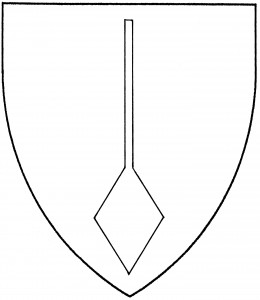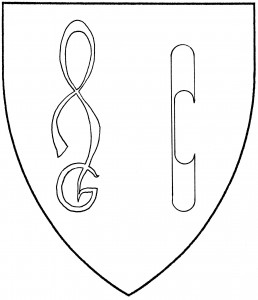A musical note is a written symbol, indicating pitch and duration to the performer. Musical notation had evolved continuously, from the “neumes” of the 10th Century to the stemmed ovoids of modern notation. In Society armory, the musical note is commonly represented as a lozenge with a vertical stem out of its top corner, as used in 16th C. Italian notation [Grove 18:136]. Specific types of notes may be blazoned a “fusa”, a “(semi)minim”, or a “(semi)quaver”, depending on the period and the exact form; no heraldic difference is granted.
Though we’ve no examples of their use as independent heraldic charges, musical notes were used to embellish charges in period armory, such as the “prick-song book” in the crest of the Worshipful Company of Parish Clerks, 1582 [Bromley & Child 191].
Other musical symbols were used as period charges: the arms of the composer Orlando di Lasso, 1570, uses the symbols “sharp”, “flat”, and “natural” as charges [Woodward 387]. Society armory also has examples of clefs, such as the “G-clef” and “C-clef”; the illustrations are taken from 16th C. scores [Grove 6:26]. In all cases, period forms of the notation should be used.
Musical notation is exempt from the Society’s requirement that armory not consist solely of letters or similar symbols.
Quinlan of Sheare bears: Argent, on a chevron azure three quavers palewise argent.
Vincenzio di Bartolomeo da Brescia bears: Azure, three quavers argent.
Ivory Genevieve la Rouge bears: Vert, on a bend sinister between a G clef and a fleur-de-lys argent an ivy vine throughout vert.

